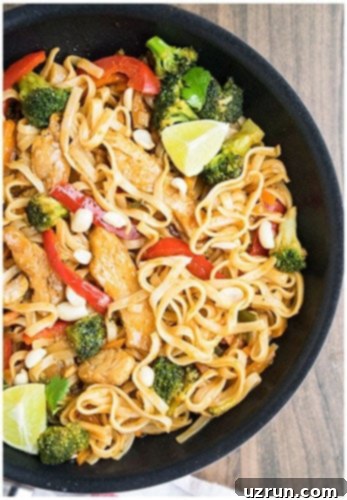Easy 30-Minute Chicken Pad Thai Recipe: Authentic Flavor for Weeknight Dinners
Craving a delicious, restaurant-quality Pad Thai but short on time? This easy-to-follow Chicken Pad Thai recipe brings the vibrant flavors of Thailand right into your kitchen in just 30 minutes! Perfect for a quick weeknight meal, it’s packed with succulent chicken, perfectly cooked rice noodles, a tantalizing sweet, sour, and spicy sauce, and, of course, a generous sprinkle of crunchy peanuts. Get ready to impress your taste buds and simplify your dinner routine!
My journey to mastering homemade Pad Thai began during my college years. Like many students, I found myself frequently relying on takeout, and my favorite Thai restaurant quickly became a significant drain on my budget. I loved the complex flavors of Pad Thai but knew there had to be a more cost-effective and equally delicious way to enjoy it.
Determined to recreate the magic at home, I embarked on a culinary adventure. I experimented with numerous recipes from cookbooks and online resources, mixing and matching techniques and ingredients until I developed a version that perfectly captured the essence of my favorite Thai dish. This particular recipe for Chicken Pad Thai is designed with beginners in mind, making it accessible for anyone eager to try their hand at Thai cooking. While I can’t definitively claim it’s a 100% “authentic” street-style Pad Thai, I can assure you it tastes remarkably similar to the one I used to order religiously from my local Thai spot.
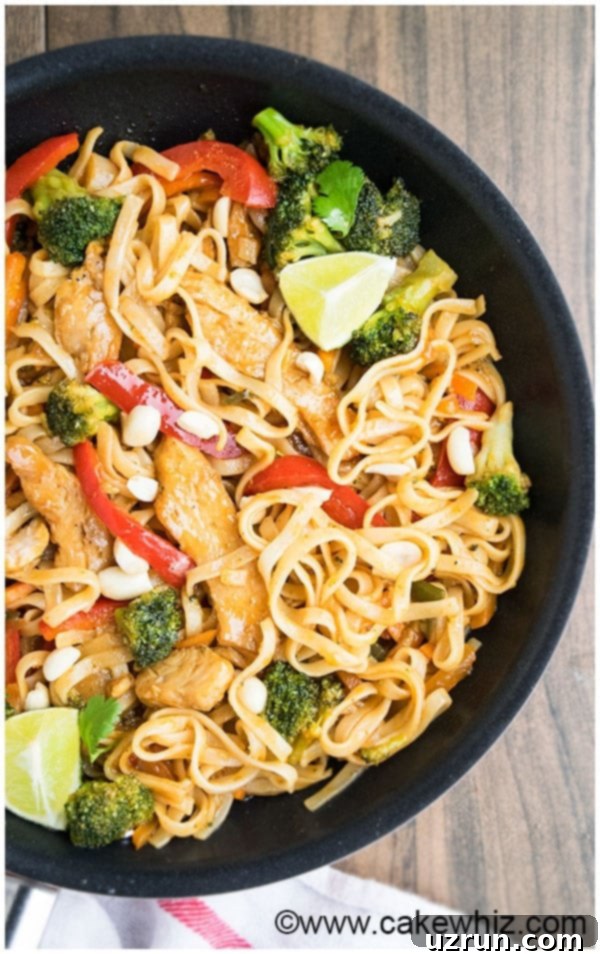
Why You’ll Love This Homemade Chicken Pad Thai
There are countless reasons to make Pad Thai at home, but here’s why this recipe stands out:
- Speed and Simplicity: Forget complicated techniques! This recipe is genuinely a 30-minute wonder, making it ideal for busy weeknights when you need a flavorful meal fast.
- Unforgettable Flavor: The homemade Pad Thai sauce strikes the perfect balance of sweet, sour, salty, and a customizable spicy kick, mimicking the complex taste of your favorite Thai takeout.
- Budget-Friendly: Save a significant amount of money by preparing this dish at home instead of ordering in. You control the ingredients, ensuring quality and freshness.
- Customizable: Easily adjust the spice level, swap proteins, or add your favorite vegetables to make it truly your own.
- Fresh Ingredients: Using fresh ingredients ensures a vibrant taste and texture that pre-made sauces or kits simply can’t match.
Over the years, I’ve become a bit more experimental with this delightful Thai meal. I’ve tried it with ramen noodles, udon noodles, and even daikon noodles. However, I always find myself returning to classic chicken Pad Thai with rice noodles. Their delicate texture and ability to absorb the rich sauce make them the undisputed champion for this dish. A few weeks ago, I even attempted a version with zoodles (zucchini noodles), and I must confess, it was a complete disaster! I strongly advise against it – trust me on this one. While I appreciate healthier alternatives, some dishes are best left in their traditional form. I also tried a “healthy” Pad Thai at a friend’s place once, and while I’m sure it was lower in calories, it just didn’t deliver the same satisfying flavor.
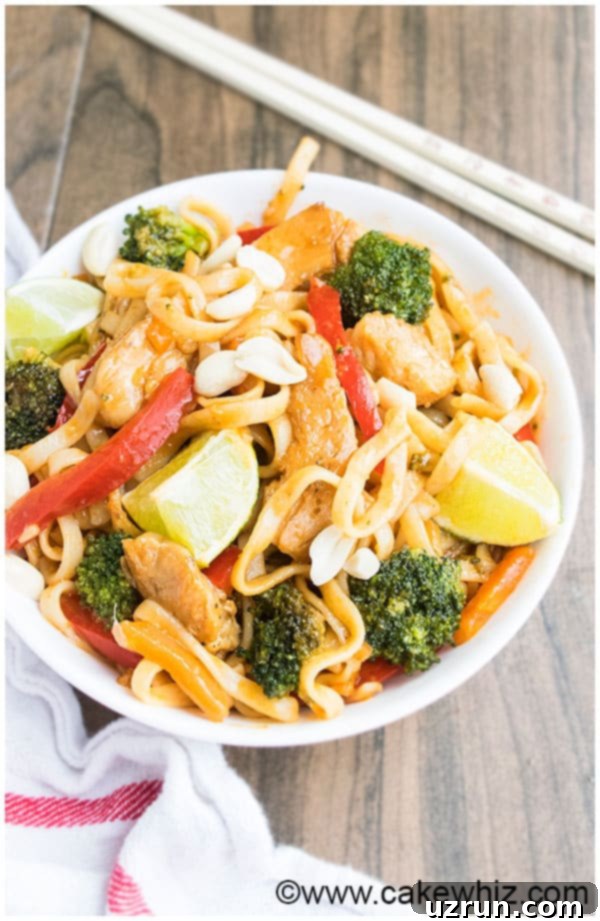
Essential Tips for Crafting the Perfect Homemade Chicken Pad Thai
To ensure your homemade Chicken Pad Thai turns out spectacularly every time, keep these crucial tips in mind:
- Stick to the Ingredients: For your first attempt, I highly recommend against making omissions or major substitutions in the ingredient list, especially for the sauce. Each component plays a vital role in creating the signature Pad Thai flavor profile.
- Source Your Asian Ingredients: Key ingredients like rice noodles, fish sauce, oyster sauce, tamarind paste/concentrate, and Thai red chili sauce (Sambal Oelek) are readily available. You can typically find them in the Asian aisle of larger grocery stores or, for a wider selection, at your local Asian market.
- Adjust the Spice to Your Liking: Pad Thai generally has a pleasant spicy kick, but you are the chef! Feel free to adjust the amount of Thai red chili sauce to match your preference. A clever trick a friend uses is adding a ¼ cup of coconut milk to the sauce. She says it effectively mellows the spiciness while adding a creamy richness, without sacrificing flavor.
- Go Meatless: Easily transform this into a vegetarian or vegan Pad Thai by substituting chicken with firm tofu (pressed and pan-fried until golden) or soy chunks. Ensure your fish sauce is replaced with a vegan alternative if making it fully vegan.
- Embrace Rice Noodles: Seriously, resist the urge to use spaghetti or any other non-rice noodle. Rice noodles are fundamental to achieving the authentic texture and subtle chewiness of Pad Thai. Using other noodles will significantly alter the dish.
- Frozen Veggies are Your Friend: If time is of the essence or fresh produce isn’t handy, don’t hesitate to use frozen stir-fry vegetables. Just ensure they are thawed and drained before adding them to prevent excess moisture.
- Don’t Skip Roasting the Peanuts: Dry roasting the peanuts (either in a dry skillet or oven) before garnishing significantly enhances their flavor and crunch, adding a layer of depth to the dish.
- Extra Sauce for Sauce Lovers: If you enjoy your Pad Thai noodles generously coated in sauce, simply double the sauce recipe. You can then add as much as you like to achieve your desired sauciness.
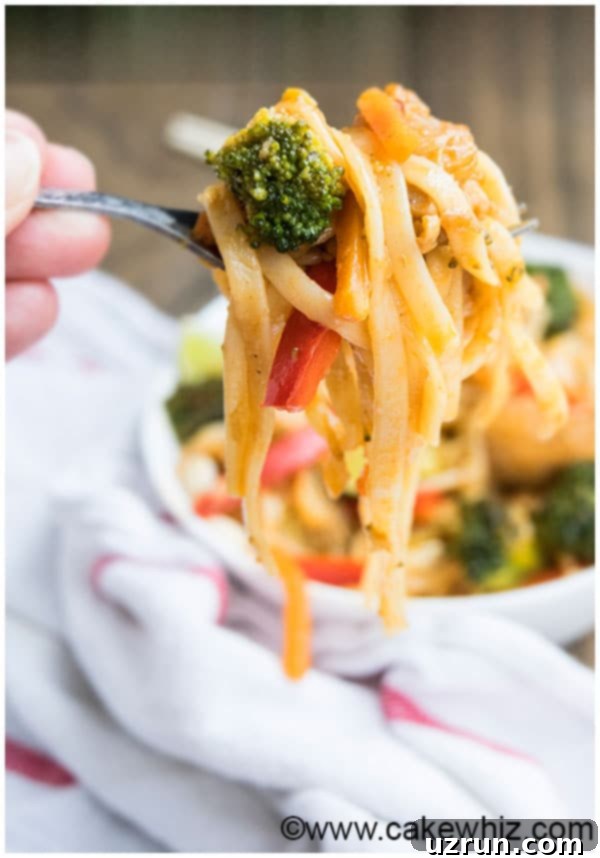
Frequently Asked Questions About Chicken Pad Thai
Here are a few common questions and answers to help you navigate this easy weeknight meal:
How do you make Pad Thai from scratch? How do you cook Pad Thai noodles?
The process is remarkably simple and contributes to its 30-minute meal status. First, prepare your rice noodles according to package instructions (usually involving a quick soak or boil), then set them aside. Next, whisk together all the ingredients for the homemade Pad Thai sauce in a small bowl and keep it ready. In a non-stick skillet or wok, cook your chicken pieces until lightly browned, then add shallots, ginger, and garlic to sauté until fragrant. Introduce your chosen vegetables and stir-fry them until tender-crisp. Push everything to one side and quickly scramble an egg in the empty space, then mix it into the chicken and vegetables. Finally, add the prepared noodles, a squeeze of fresh lime juice, and the glorious Pad Thai sauce. Toss everything together vigorously, cooking for a few more minutes until the sauce has thickened and coated the noodles beautifully. Garnish generously with roasted peanuts, fresh cilantro, and extra lime wedges, then serve immediately!
What are the essential ingredients in Pad Thai?
Traditional Pad Thai is fundamentally built upon:
- Rice noodles: The chewy foundation of the dish.
- Boneless chicken breast: Cut into small, quick-cooking pieces (or your protein of choice).
- Tamarind concentrate: Provides the distinctive sour and tangy element.
- Thai red chili sauce (Sambal Oelek): For that adjustable spicy kick.
- Fish sauce: Crucial for the savory, umami depth that defines Thai cuisine.
- Oyster sauce: Adds a touch of sweetness and another layer of savory flavor.
- Brown sugar: Balances the sourness and spice with its rich sweetness.
- Aromatics: Fresh ginger, garlic, and shallots form the fragrant base.
- Egg: Scrambled and mixed in for texture and richness.
- Vegetables: A medley of your choice, commonly including bell peppers, carrots, and bean sprouts.
- Garnish: Roasted peanuts and fresh cilantro are non-negotiable for flavor and texture.
How do you cook tofu for Pad Thai?
For tofu, cut it into bite-sized cubes, press out excess water, and then stir-fry it in a separate pan with a little sesame oil until golden brown and crispy. This step helps it retain its shape and absorb flavor. Add the cooked tofu to the noodles at the very end, just before serving, to prevent it from breaking apart.
What is a good substitute for fish sauce? Can you substitute soy sauce for fish sauce? Can you use oyster sauce instead of fish sauce?
While I highly recommend using fish sauce for its unique umami profile, if absolutely necessary, some people use a combination of soy sauce and Worcestershire sauce as a substitute. However, please note that the flavor will not be identical. Oyster sauce cannot be used as a direct substitute for fish sauce, as it has a different flavor and consistency; it’s typically used in addition to fish sauce for a richer taste.
What is a good substitute for tamarind concentrate/paste/sauce?
Tamarind paste is essential for Pad Thai’s signature tangy-sweet flavor. While some recipes suggest lime juice or rice vinegar, I strongly advise against it for Pad Thai. Tamarind has a unique, complex fruitiness that limes or vinegar simply cannot replicate, and omitting it will significantly alter the authentic taste of the dish.
Is Pad Thai spicy?
Generally, Thai food, including Pad Thai, has a noticeable spicy kick. However, the beauty of homemade Pad Thai is that you can easily adjust the level of spiciness to your preference by adding more or less Thai red chili sauce (Sambal Oelek).
What is Pad Thai sauce? How do you make Pad Thai sauce?
The magic of Pad Thai lies in its perfectly balanced sauce. It’s a harmonious blend of sweet, tangy, and subtly spicy, which gives the noodles their truly unique and addictive flavor. Our homemade Pad Thai sauce is crafted from tamarind concentrate (for tang), fish sauce (for umami and saltiness), oyster sauce (for richness and a hint of sweetness), Thai red chili sauce (for heat), and brown sugar (to balance the sourness and spice).
What vegetables can you put in Pad Thai?
Pad Thai is incredibly versatile when it comes to vegetables. You can add a colorful assortment to boost flavor and nutrition. Popular choices include:
- Thinly sliced red bell peppers
- Thinly sliced green bell peppers
- Shredded or thinly sliced carrots
- Fresh bean sprouts (add at the very end for crunch)
- Broccoli florets (steamed or stir-fried until tender-crisp)
- Snow peas
- Cabbage (shredded)
- Mushrooms (sliced)
How does Pad Thai taste like? What does chicken Pad Thai taste like?
Chicken Pad Thai offers a captivating symphony of flavors: it’s simultaneously sweet from the brown sugar, tangy from the tamarind, savory and umami-rich from the fish and oyster sauces, and subtly spicy from the chili. This complex flavor profile is beautifully complemented by the tender chicken, soft rice noodles, and a delightful crunch from the roasted peanuts.
How long is chicken Pad Thai good for? How to store chicken Pad Thai? How to reheat chicken Pad Thai?
Pad Thai is always best enjoyed fresh off the wok. However, you can store any leftovers in a sealed airtight container in the refrigerator for up to 2 days. To reheat, simply use a microwave or gently warm it on the stovetop with a splash of water or broth to help rehydrate the noodles and sauce, preventing them from drying out.
How to make chicken Pad Thai with peanut sauce?
Based on extensive research and countless recipes I’ve tried, authentic Pad Thai does not traditionally include a creamy peanut sauce or peanut butter in the main dish. Instead, the dish gets its characteristic nutty flavor and satisfying crunch from a generous topping of dry-roasted, crushed peanuts. If you prefer a peanut-sauce based noodle dish, you might be thinking of a different Thai-inspired recipe, but for true Pad Thai, stick to the roasted peanut garnish!
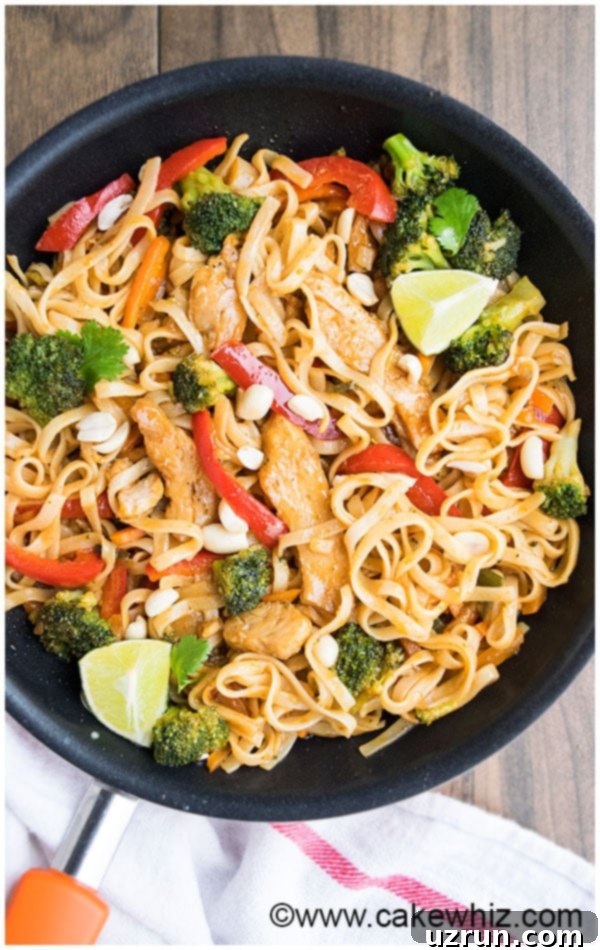
Recipe: Quick & Easy Chicken Pad Thai
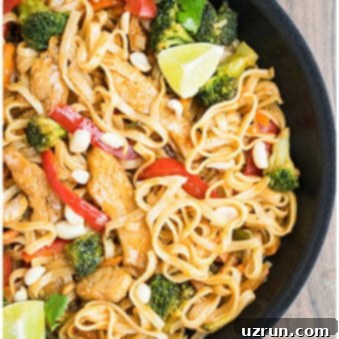
Chicken Pad Thai
Abeer Rizvi
10
20
30
Main Course
Thai
4 people
445 kcal
Want to Save This Recipe?
Enter your email & I’ll send it to your inbox. Plus, get great new recipes from me every week!
By submitting this form, you consent to receive emails from CakeWhiz
Ingredients
Pad Thai sauce:
- ¼ cup Tamarind concentrate
- 5 tablespoon Fish sauce
- 3 tablespoon Oyster sauce
- 1 tablespoon Thai red chilli sauce (Sambal Oelek)
- 3 tablespoon Brown sugar
- Pinch of crushed red chillies
Pad Thai noodles:
- 6 oz Rice noodles
- 2 tablespoon Oil (vegetable, corn or canola)
- 1 Chicken breast (cut into small cubes)
- Salt and pepper to taste
- 1 Finely chopped shallot
- 1 teaspoon Freshly grated ginger
- 2 Finely minced garlic cloves
- ⅓ cup Red peppers
- ⅓ cup Green peppers
- ⅓ cup Broccoli florets
- ⅓ cup Thinly sliced carrots
- 1 Large egg
- Half a lime
- Additional fish sauce (based on your preference)
Garnish:
- ⅓ cup Roasted peanuts
- 1 tablespoon Finely chopped cilantro
- 1 Lime (sliced into four pieces)
Instructions
-
Prepare the noodles according to the package instructions. Drain well and set aside.
-
While the noodles are cooking, prepare the Pad Thai sauce. In a small mixing bowl, combine the tamarind concentrate, fish sauce, oyster sauce, red chili sauce, brown sugar, and a pinch of crushed red chilies. Whisk until well combined and set aside.
-
In a large wok or deep non-stick skillet, heat the oil over medium-high heat. Add the chicken pieces, seasoned with salt and pepper. Cook for a few minutes until golden brown and cooked through.
-
Add the finely chopped shallots, freshly grated ginger, and minced garlic to the pan with the chicken. Stir-fry for about 1-2 minutes until fragrant.
-
Stir in the red peppers, green peppers, broccoli florets, and thinly sliced carrots. Continue to stir-fry for 3-4 minutes until the vegetables are tender-crisp.
-
Push all the chicken and vegetables to one side of the wok. Crack the large egg into the empty space and scramble it quickly until cooked. Once scrambled, mix it with the rest of the chicken and vegetables.
-
Add the boiled rice noodles to the wok. Pour the prepared Pad Thai sauce over the noodles and other ingredients. Using tongs or two spatulas, toss everything together until the noodles are evenly coated with the sauce. Cook for a few more minutes, allowing the sauce to thicken slightly and cling to the noodles. Be careful not to overcook, as this can make the noodles mushy.
-
Squeeze the juice from half of a lime over the noodles and add additional fish sauce to taste, if desired. Toss once more to combine.
-
Serve immediately, garnished generously with roasted peanuts, finely chopped cilantro, and lime wedges. Enjoy your delicious homemade Pad Thai!
Notes
Nutrition
Carbohydrates: 64g
Protein: 14g
Fat: 15g
Saturated Fat: 2g
Cholesterol: 59mg
Sodium: 2325mg
Potassium: 518mg
Fiber: 3g
Sugar: 22g
Vitamin A: 540IU
Vitamin C: 38.5mg
Calcium: 71mg
Iron: 1.9mg
An automated tool is used to calculate the nutritional information. As such, I cannot guarantee the accuracy of the nutritional information provided for any recipe on this site.
Tried this recipe?Leave a comment below or rate and tag @cakewhiz on social
More Easy Dinner Recipes You Might Enjoy
If you loved this quick and easy Chicken Pad Thai with its vibrant homemade sauce, you might also enjoy exploring some of these other delightful and simple dinner recipes:
- Slow Cooker Sesame Chicken
- Slow Cooker Orange Chicken
- Chinese Lemon Chicken
- Slow Cooker Beef and Broccoli
- Jalapeno Chicken
- Spicy Beef Stir Fry
Until next time, happy cooking my lovelies!
